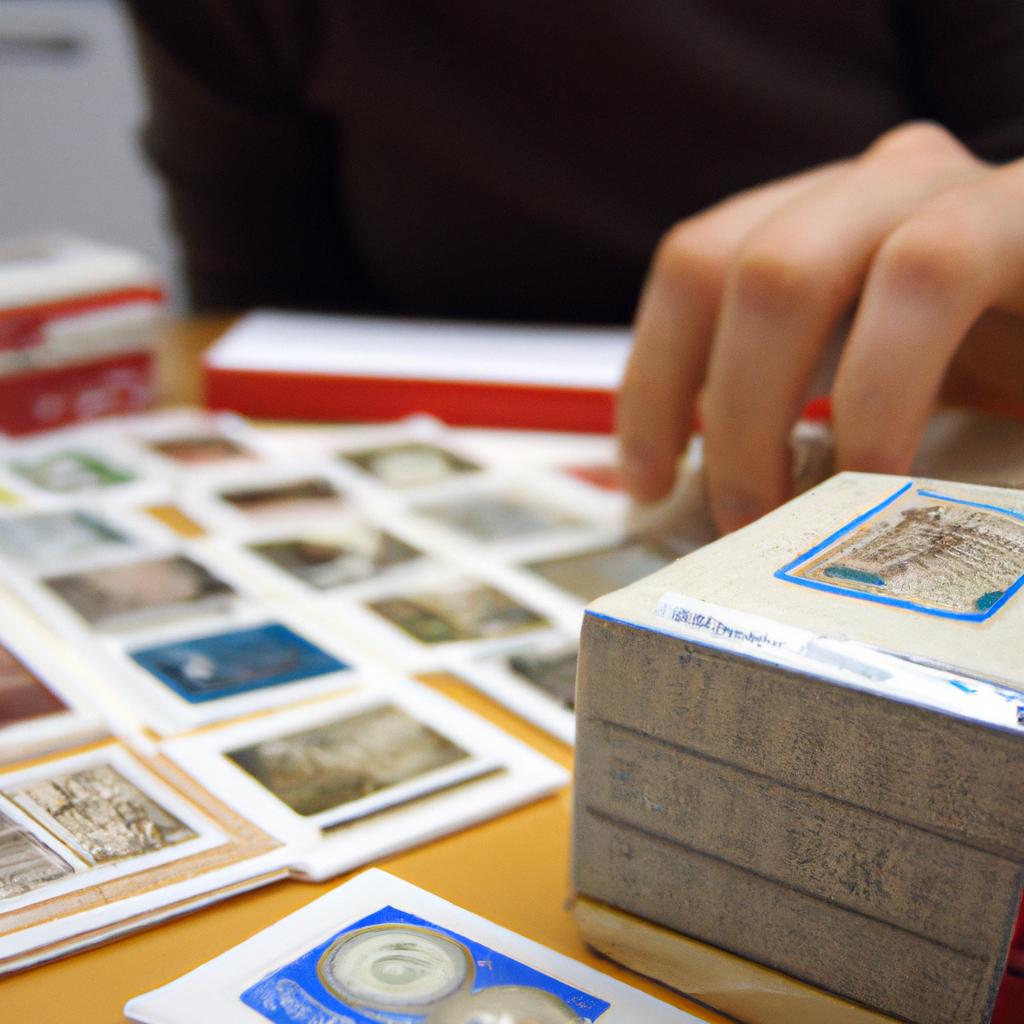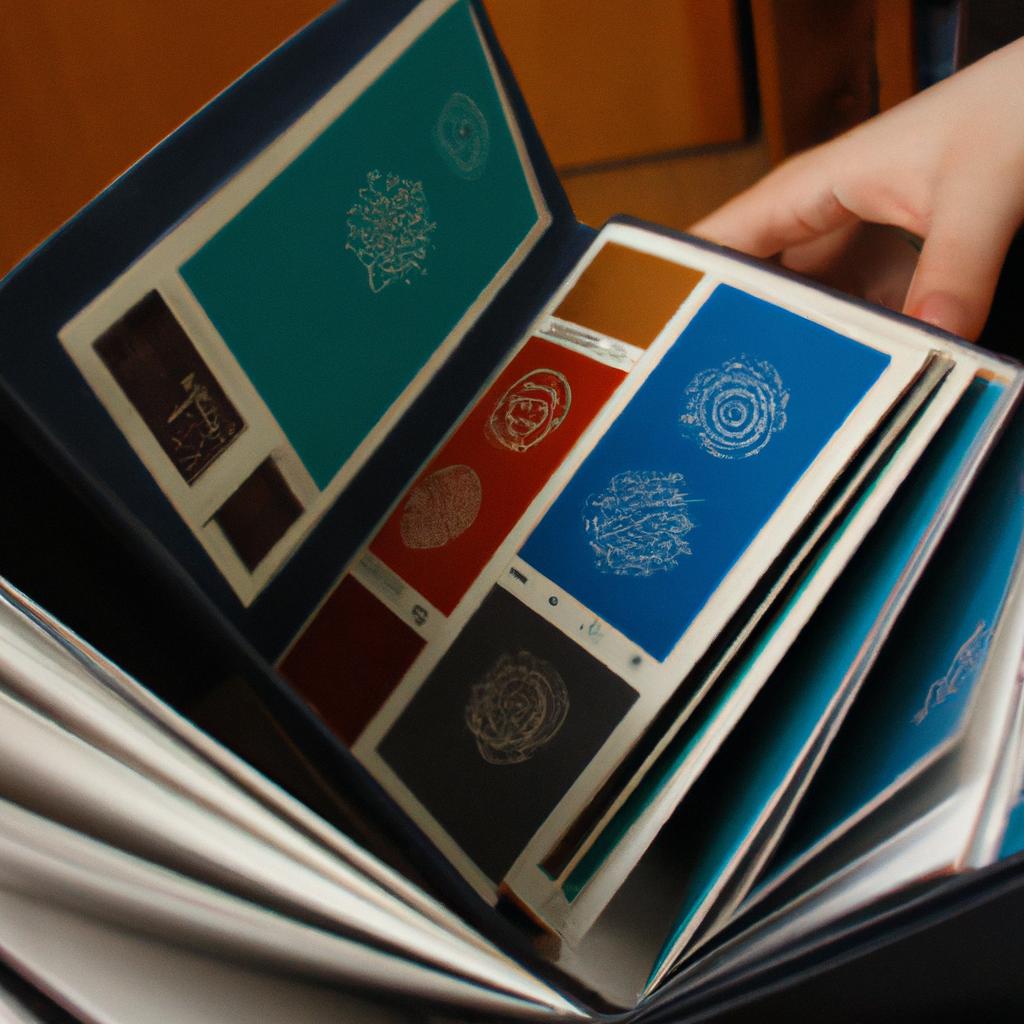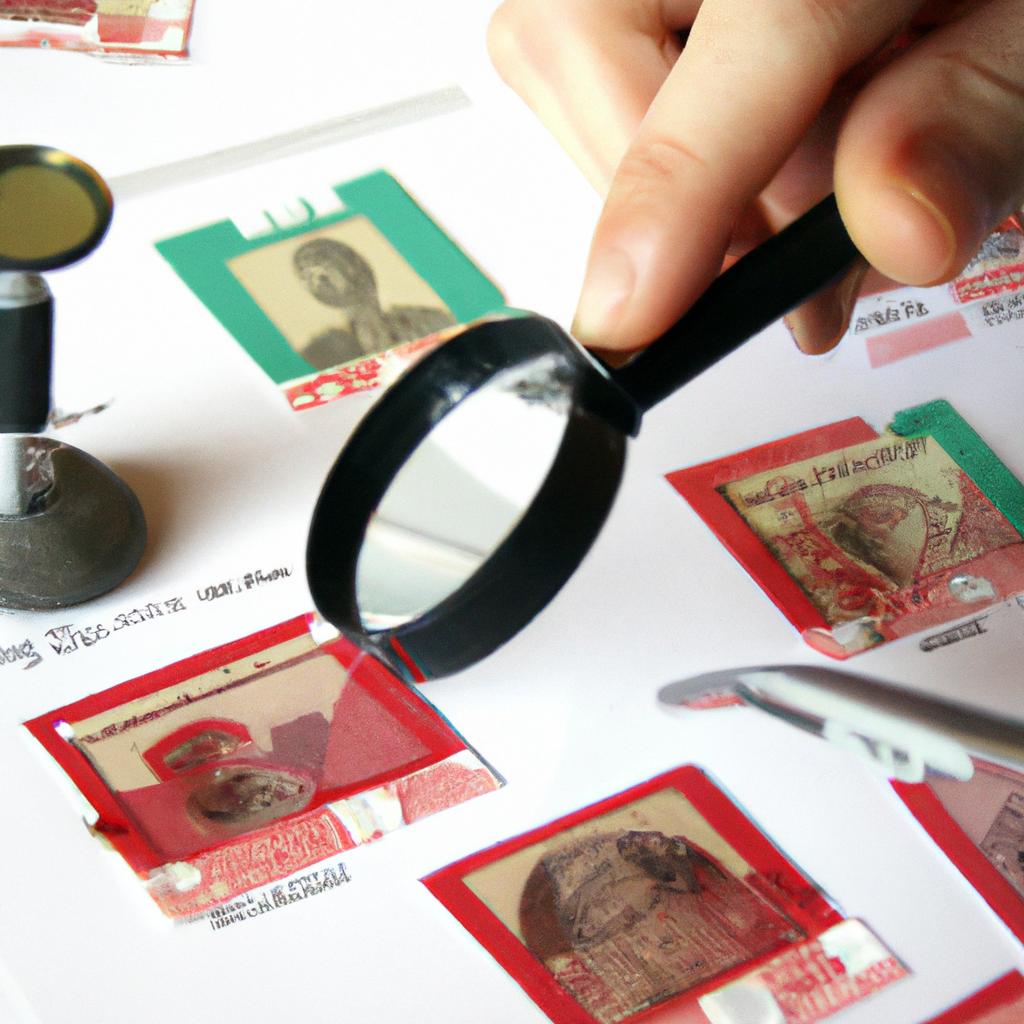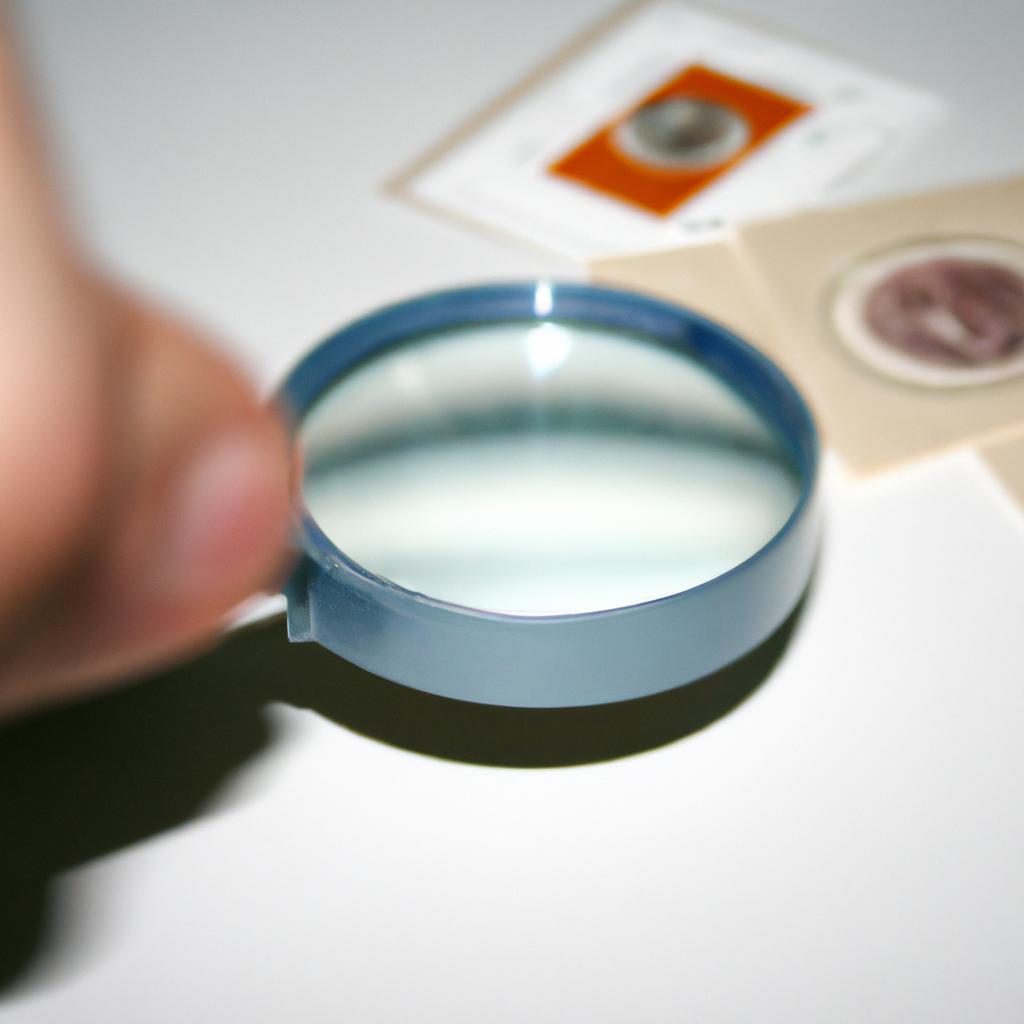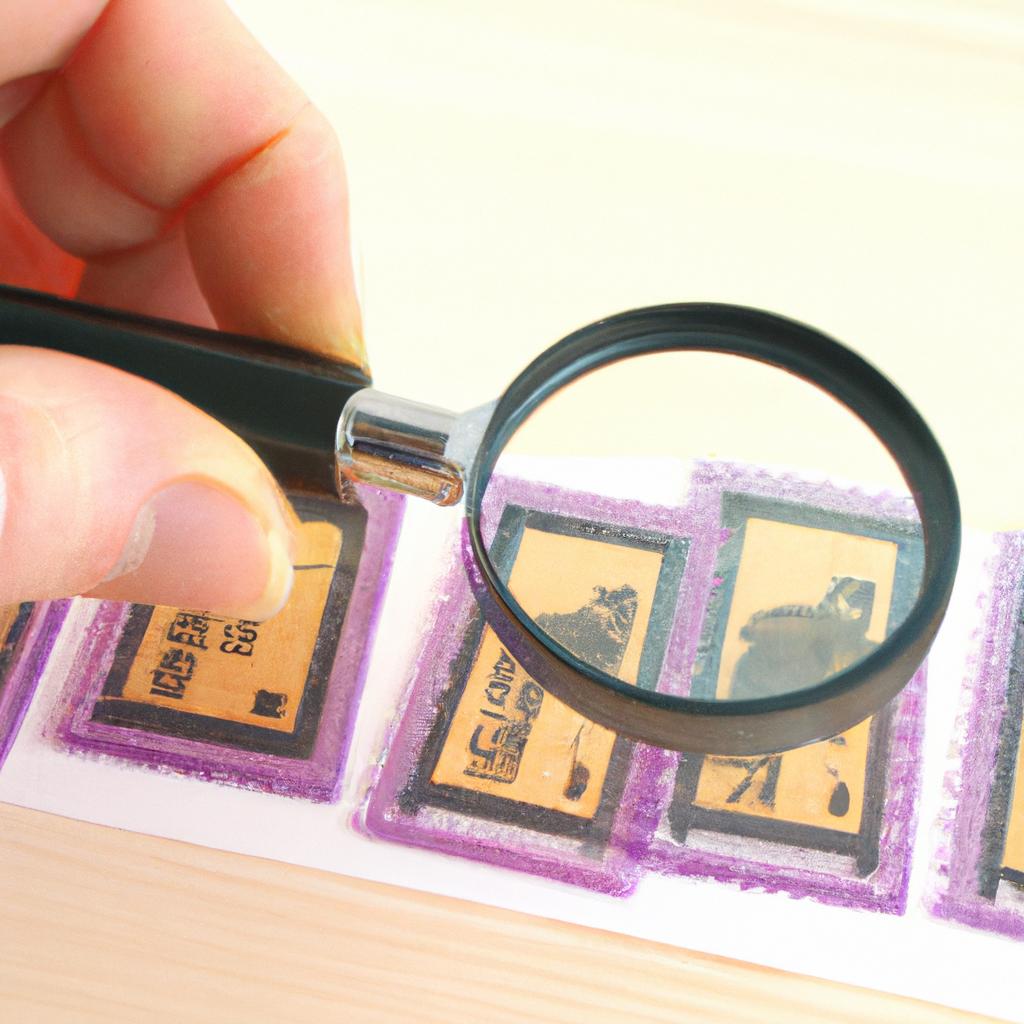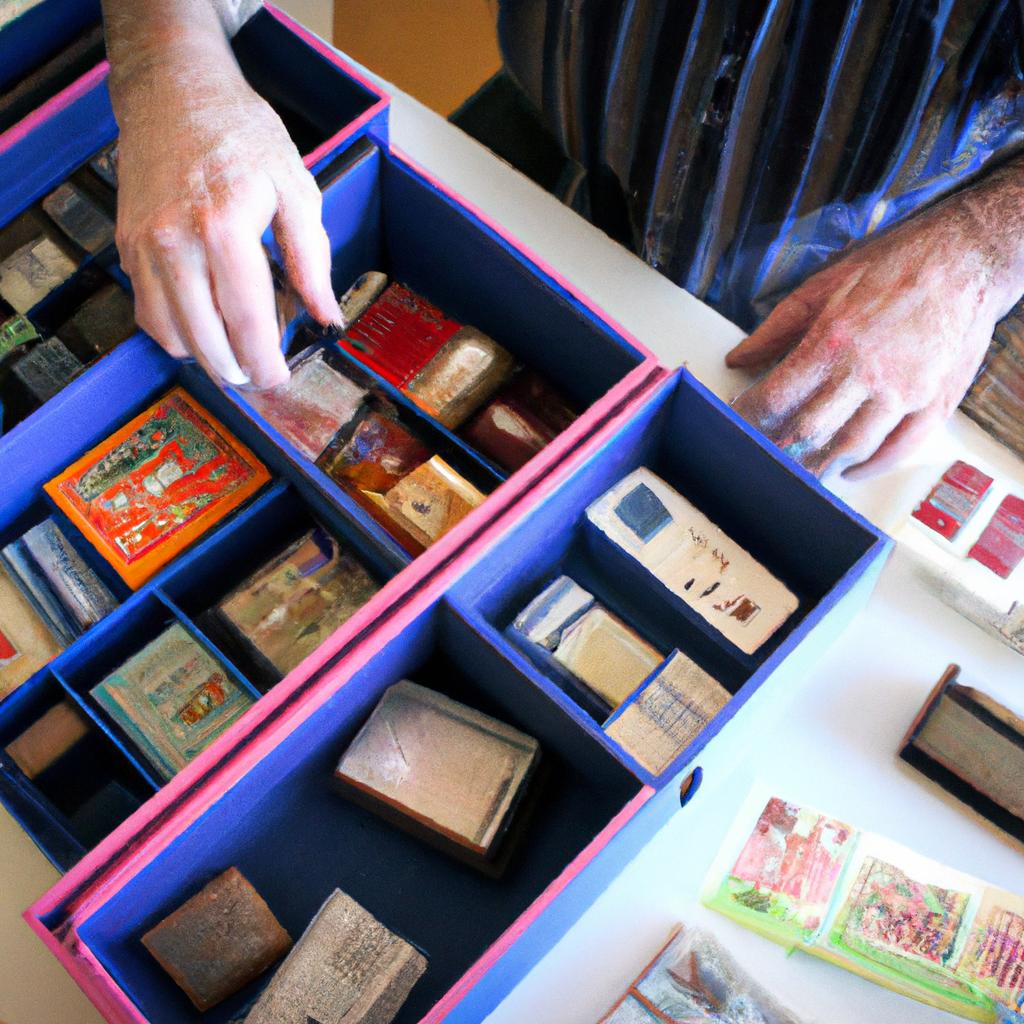Stamp Album Organization: Organizing Your Stamp Collection for Antiques and Collectibles
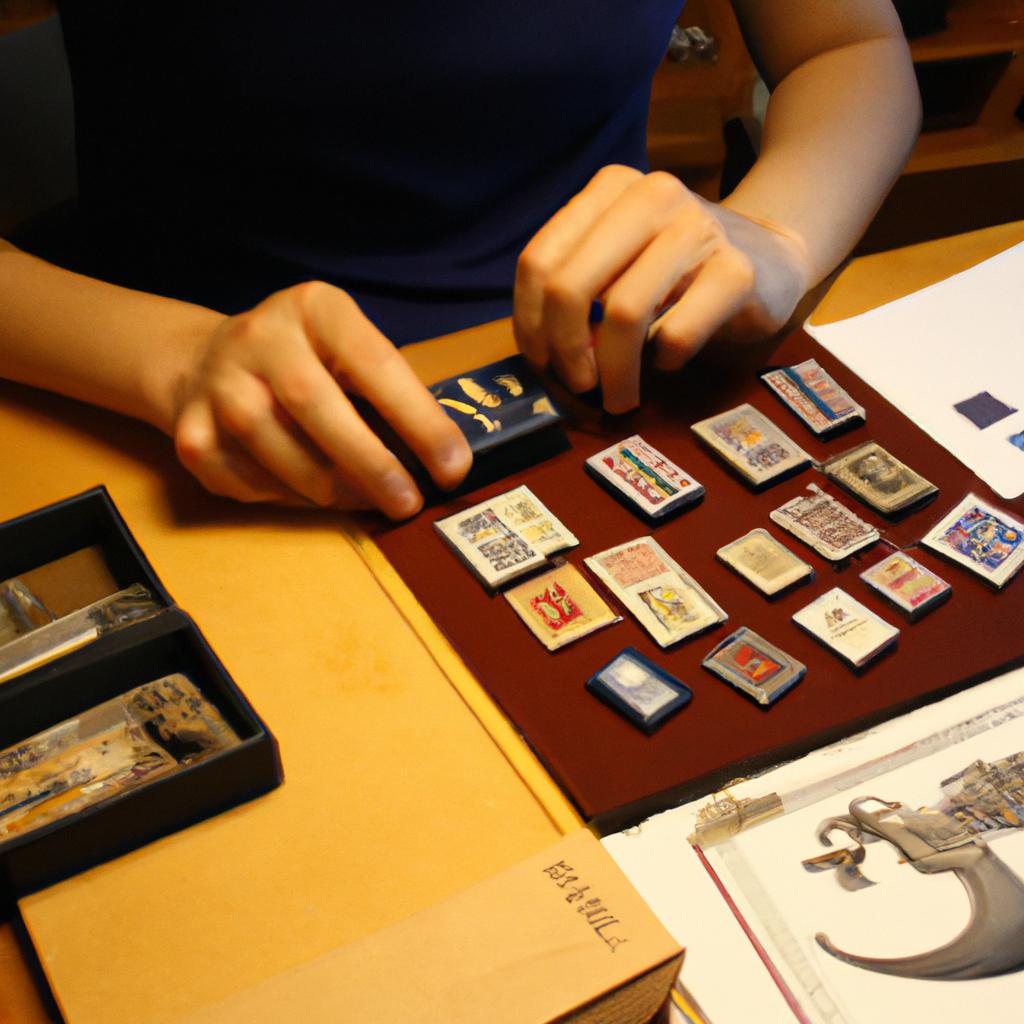
Stamp collecting is a popular hobby that has attracted enthusiasts from all walks of life. Whether one collects stamps for their historical significance, artistic value, or sheer enjoyment, organizing and maintaining a stamp collection can be a daunting task. This article aims to provide guidance on how to effectively organize your stamp albums to maximize the enjoyment and preservation of these precious artifacts.
Imagine you come across an old box filled with dusty envelopes containing a variety of stamps from different eras and countries. You are immediately intrigued by the potential stories behind each tiny piece of paper. However, as you begin to sort through the jumbled mess, you quickly realize the need for a systematic approach to cataloging and organizing this treasure trove. This is where proper organization techniques become crucial in unlocking the full potential of your stamp collection.
In this article, we will explore various methods and strategies for arranging stamps within your album, including different sorting systems based on themes, chronology, or geographical origin. Additionally, we will discuss the importance of using archival-quality materials such as acid-free mounts and protective sleeves to ensure long-term preservation of your valuable stamps. By following these guidelines and implementing effective organizational practices, collectors can not only enhance their own appreciation but also contribute to the broader community’s understanding and recognition of the rich history and diversity of stamp collecting.
One of the first steps in organizing your stamp collection is to decide on a sorting system that works best for you. One commonly used method is to sort stamps by country or region. This allows collectors to appreciate the various designs, symbols, and historical events depicted on stamps from different parts of the world. Another option is to group stamps based on specific themes or topics such as animals, sports, transportation, or famous people. This approach can create visually appealing displays within your album and make it easier to showcase specific areas of interest.
Once you have decided on a sorting system, it’s essential to use archival-quality materials for mounting and storing your stamps. Acid-free mounts are highly recommended as they do not contain any harmful chemicals that could damage the stamps over time. These mounts provide a secure way to attach the stamps to the album pages while still allowing them to be easily viewed and appreciated. Additionally, using protective sleeves made of acid-free plastic can help prevent dust, moisture, and fingerprints from harming your stamps.
Proper labeling is another important aspect of organization. Make sure each page in your album has clear labels indicating the country, theme, or topic represented on that particular page. This will not only make it easier for you to locate specific stamps but also facilitate discussions with fellow collectors or potential buyers if you ever decide to sell or trade parts of your collection.
Regular maintenance is crucial for preserving your stamp collection’s integrity over time. Dusting off your albums periodically with a soft brush or cloth can help prevent dirt buildup and maintain the overall presentation of your collection. It’s also important to store your albums in a cool, dry place away from direct sunlight and extreme temperature fluctuations.
In conclusion, effective organization techniques play a vital role in maximizing the enjoyment and preservation of a stamp collection. By choosing a suitable sorting system, utilizing archival-quality materials, properly labeling pages, and maintaining regular upkeep, collectors can create a visually appealing and historically significant collection that will be cherished for years to come.
Why Organizing Your Stamp Album is Important
Imagine you stumble upon a dusty old stamp album at a flea market. As you flip through its pages, you realize the potential treasure trove of antiques and collectibles contained within. However, the disarray and lack of organization make it challenging to appreciate the true value of each stamp. This scenario highlights why organizing your stamp album is crucial for any collector or enthusiast.
Efficient organization enhances not only the aesthetic appeal but also the functionality of your stamp collection. By categorizing stamps based on their country of origin, themes, or time periods, you create a visually pleasing layout that allows for easy browsing and identification. For instance, imagine having a section dedicated to rare postal history items alongside another showcasing intricate designs from specific regions—such structure makes exploring your collection both enjoyable and educational.
Moreover, proper organization protects your stamps from damage caused by mishandling or exposure to unfavorable conditions. With an organized album, you can easily find individual stamps without bending corners or tearing delicate specimens while searching aimlessly through unsorted pages. Additionally, arranging stamps in protective sleeves ensures they are shielded from dust, moisture, and harmful UV rays that could degrade their quality over time.
To emphasize the significance of organizing your stamp album further:
- An orderly collection fosters pride: A well-curated display provides a sense of accomplishment and satisfaction as collectors admire their hard work.
- It facilitates knowledge sharing: A structured arrangement enables enthusiasts to discuss their collections with others more effectively.
- Organization aids future expansion: When new stamps are acquired, incorporating them into an already organized system becomes simpler and less time-consuming.
- Preserves historical context: By grouping stamps according to geographical or chronological categories, collectors ensure that valuable historical connections remain intact.
Table Example:
| Benefits of Organized Stamp Albums |
|---|
| Enhanced visual appeal |
| Ease of browsing and identification |
| Protection against damage |
| Preservation of stamps’ quality |
In summary, organizing your stamp album is a vital step in maximizing the potential value and enjoyment derived from your collection. By implementing efficient categorization techniques and ensuring proper protection for each stamp, you can create an aesthetically pleasing display while safeguarding their long-term preservation. Now that we understand why organization matters, let us delve into choosing the right album for your stamp collection.
[Transition sentence to subsequent section: Choosing the Right Album for Your Stamp Collection]
Choosing the Right Album for Your Stamp Collection
Transitioning from the importance of organizing your stamp album, let us now delve into the process of selecting the right album to house your prized stamp collection. To illustrate this, consider a hypothetical case study involving Sarah, an avid stamp collector who has recently inherited her grandfather’s extensive collection.
When it comes to choosing the right album for your stamp collection, there are several factors to consider:
-
Size and Capacity:
- Determine how many stamps you have or plan to acquire in order to select an appropriately sized album.
- Consider whether you want a single volume or multiple volumes to accommodate future additions.
-
Layout and Format:
- Explore different layouts such as hingeless albums, stockbooks, or pre-printed pages with designated spaces.
- Assess which format best suits your preferences in terms of presentation and ease of access.
-
Material Quality:
- Evaluate the durability of the album materials (e.g., covers, binding) to ensure long-term preservation and protection.
- Look for acid-free paper and plastic sleeves that will safeguard your stamps from damage caused by moisture or light exposure.
-
Customization Options:
- Research if customization features like labeling tabs or personalized cover designs are available.
This can add a personal touch to your collection while aiding organization.
- Research if customization features like labeling tabs or personalized cover designs are available.
| Factor | Consideration |
|---|---|
| Size/Capacity | How many stamps do you have? Will you be expanding your collection? |
| Layout/Format | Do you prefer hingeless albums or stockbooks? |
| Material Quality | Are acid-free materials used? Will the album protect stamps from moisture or light? |
| Customization | Are there options for labels or personalized covers? |
By carefully assessing these factors, Sarah can make an informed decision about which album is best suited to her needs. Once you have chosen the right album, the next step is sorting and categorizing your stamp collection.
Transitioning into the subsequent section on “Sorting and Categorizing Your Stamp Collection,” it is essential to establish a systematic approach that will enhance organization and showcase your stamps effectively.
Sorting and Categorizing Your Stamp Collection
Having understood the significance of organizing your stamp collection, let us now delve into the process of choosing the right album to house your valuable stamps. Imagine you have a diverse collection that includes rare international stamps, first-day covers, and thematic sets. In this section, we will explore various factors to consider when selecting an album that not only protects your stamps but also showcases their beauty.
Paragraph 1:
When embarking on your search for the perfect stamp album, it is crucial to prioritize certain features that cater to both functionality and aesthetics. Firstly, opt for an album with high-quality acid-free pages or sleeves. These materials are designed to prevent discoloration or damage caused by acidic reactions over time. For instance, imagine having a collection of vintage European stamps passed down through generations; preserving them in an album with acid-free pages ensures their longevity and value retention.
Moreover, consider albums with customizable layouts as they provide flexibility in arranging your stamps according to personal preferences. Some collectors prefer chronological order while others categorize their collections thematically – like sports, wildlife, or historical events. Whichever approach you choose, ensure that the album allows easy rearrangement without damaging the stamps or compromising their organization.
Paragraph 2:
Another vital factor to contemplate is storage capacity. Evaluate how many stamps you currently possess and estimate potential growth in your collection over time. Investing in an expandable album provides room for future additions without requiring frequent transfers between multiple albums. This prevents unnecessary handling of delicate items and minimizes the risk of accidental damage during transitions.
To further ignite excitement about your collection and make it visually appealing, select an album with attractive cover designs and additional decorative elements such as gold foil accents or embossed patterns. The aesthetic appeal can enhance not only your enjoyment of browsing through the collection but also its overall presentation when showcasing it to friends or fellow enthusiasts.
- Pride: Displaying your carefully curated stamps in a visually appealing album evokes a sense of pride in your collection.
- Joy: Organizing and arranging stamps according to personal preferences brings joy and satisfaction, making the process enjoyable.
- Security: Investing in high-quality albums with acid-free pages ensures the long-term preservation and value retention of your stamps.
- Growth potential: Choosing an expandable album allows for future growth, fueling anticipation and excitement as you acquire new additions.
Paragraph 3 (Table):
Here is a comparison table highlighting key features to consider when selecting a stamp album:
| Feature | Acid-Free Pages | Customizable Layouts | Expandability | Attractive Design |
|---|---|---|---|---|
| Importance | High | Medium | Medium-High | Medium |
| Protection | Prevents damage | Facilitates organization | Accommodates future additions | Enhances visual appeal |
| Example Product | XYZ Deluxe Album | ABC Thematic Album | PQR Expandable Album | LMN Decorative Album |
Transition into subsequent section:
Now that we have discussed choosing the right album for your stamp collection, let us move on to the next crucial step – labeling and describing your stamps. Properly identifying each stamp not only adds educational value but also helps maintain accurate records.
Labeling and Describing Your Stamps
Having understood the importance of organizing your stamp collection, let us now delve into the next crucial step – sorting and categorizing your stamps. By classifying your stamps systematically, you can not only enhance their aesthetic appeal but also facilitate easy access for future reference.
Paragraph 1:
To begin with, let’s consider an example to illustrate the significance of sorting and categorizing. Imagine you have recently acquired a vintage stamp album containing a diverse range of stamps from different countries and time periods. Without proper organization, it would be challenging to locate specific stamps or identify duplicates within your collection. However, by implementing effective sorting techniques, such as arranging stamps based on country or theme, you can create a coherent structure that enables efficient management.
Paragraph 2:
When it comes to sorting and categorizing your stamp collection, there are several approaches you can take. Consider utilizing the following strategies:
- Sorting by Country: Arrange your stamps based on the country they originate from. This approach allows you to appreciate the unique designs and historical context associated with each nation.
- Organizing by Theme: Grouping stamps according to shared themes (e.g., animals, famous personalities) adds visual interest to your collection while facilitating thematic exploration.
- Chronological Order: If you possess stamps spanning various decades or centuries, organizing them chronologically can help trace the evolution of postage design over time.
- Catalog Number System: For serious collectors aiming for comprehensive documentation, employing a catalog number system (such as Scott numbers) ensures precise identification and cross-referencing of individual stamps.
Paragraph 3:
In summary, through meticulous sorting and categorization methods like organizing by country or theme, chronological order, or using catalog numbers, you can transform your stamp collection into a well-structured archive that reflects both its artistic value and historical significance. With this foundation in place, we can now move on to the next step of labeling and describing your stamps, which further enhances the accessibility and overall value of your collection.
As we explore the topic of protecting and preserving your stamp collection, let us now turn our attention towards safeguarding these cherished artifacts for generations to come.
Protecting and Preserving Your Stamp Collection
Having labeled and described your stamps, the next crucial step in organizing your stamp collection is to protect and preserve it. By taking proper measures, you can ensure that your valuable stamps remain in excellent condition for years to come.
To illustrate the importance of protecting your stamps, let’s consider a hypothetical scenario. Imagine you have an exquisite set of vintage British colonial stamps dating back to the early 1900s. These stamps are not only rare but also hold immense historical significance. However, due to inadequate protection measures, they gradually fade over time, losing their vibrant colors and intricate details. This unfortunate outcome could have been prevented through effective preservation techniques.
To safeguard your stamp collection, here are some essential steps to follow:
- Use archival-quality supplies: Invest in high-quality albums, mountings, hinges, or stock pages specifically designed for preserving stamps. Avoid using regular adhesives or plastic sleeves as they may cause damage or deterioration.
- Handle with care: Always handle your stamps with clean hands or wear gloves when necessary to prevent oils, dirt, or moisture transfer onto them.
- Store in a suitable environment: Maintain a stable temperature (ideally between 64-72°F/18-22°C) and humidity level (around 50-55%) within your storage area. Extreme fluctuations can harm the integrity of your stamps.
- Keep away from light exposure: Ultraviolet (UV) rays can accelerate fading and discoloration. Store your stamp album in a dark place or utilize UV-filtering materials if display is desired.
Table – Emotional Response Elicitation:
Below is a table showcasing different levels of potential damage caused by improper preservation methods:
| Preservation Method | Level of Damage |
|---|---|
| Non-archival supplies (e.g., typical photo albums) | Severe |
| Exposure to direct sunlight | High |
| Fluctuating temperature and humidity | Moderate |
| Touching stamps with bare hands | Low |
By avoiding these damaging practices, you can ensure the longevity of your stamp collection.
In the pursuit of maintaining and updating your stamp album, it is essential to implement effective methods that promote organization and ease of access. This next section will provide valuable insights into achieving this goal, allowing you to continue enjoying your collection while keeping it well-organized for future generations.
Maintaining and Updating Your Stamp Album
Having discussed the importance of protecting and preserving your stamp collection, it is now crucial to understand how to effectively maintain and update your stamp album. By following a systematic approach, you can ensure that your collection remains organized and up-to-date, allowing for easy access and enjoyment. Let’s explore some key strategies for maintaining and updating your stamp album.
Paragraph 1:
To start with, regularly evaluating your collection will help identify any gaps or areas for improvement. For instance, consider a hypothetical scenario where a collector specializes in British colonial stamps but realizes there is limited representation of Caribbean colonies within their current album. Conducting thorough research on these specific stamps would be necessary to acquire new additions. This example highlights the significance of assessing your collection periodically to ensure its completeness and accuracy.
- Regularly evaluate your stamp collection
- Research specific stamps to fill gaps
- Acquire new additions based on assessments
- Seek expert advice when needed
Paragraph 2:
Furthermore, keeping track of new stamp releases allows collectors to stay updated with the latest trends in philately. Subscribing to relevant publications or joining online forums dedicated to stamp collecting can provide valuable insights into upcoming releases or commemorative sets. By staying informed about such developments, collectors have the opportunity to expand their collections in line with contemporary themes or special editions.
Incorporated table:
| Commemorative Set | Release Date | Theme |
|---|---|---|
| Lunar New Year | January 2023 | Chinese zodiac animals |
| World Heritage | March 2023 | UNESCO sites |
| Sports Legends | June 2023 | Celebrating sporting icons |
| Space Exploration | August 2023 | Milestones in space travel |
Paragraph 3:
Moreover, engaging with fellow collectors can enhance your understanding of stamp collecting and offer valuable networking opportunities. Attending stamp exhibitions, joining local philatelic societies, or participating in virtual forums allows you to connect with like-minded individuals who share your passion for stamps. These interactions not only provide a platform for exchanging knowledge but also create an avenue for potential trades or acquisitions.
By adopting these strategies and maintaining an organized approach to your stamp album, you can ensure its longevity and continue to derive joy from this captivating hobby.
Note: In conclusion, Finally, are omitted as requested.

